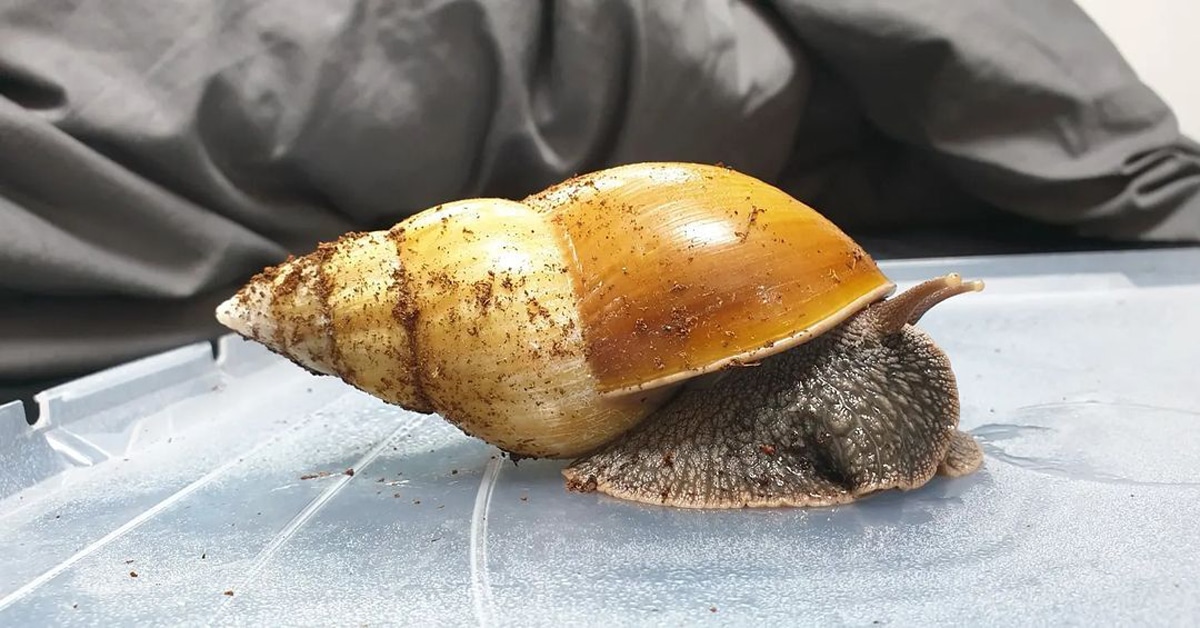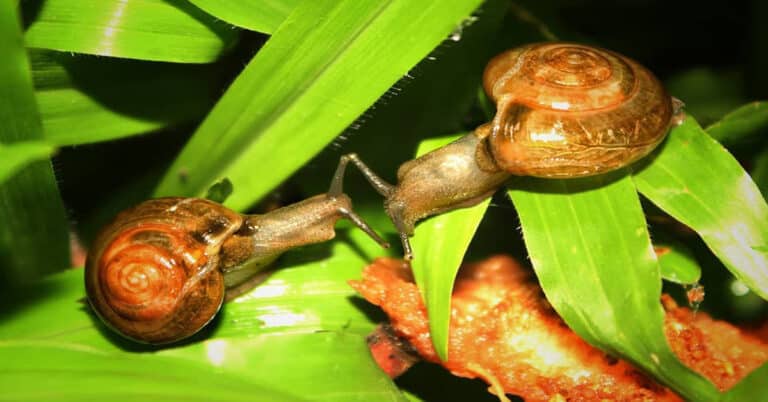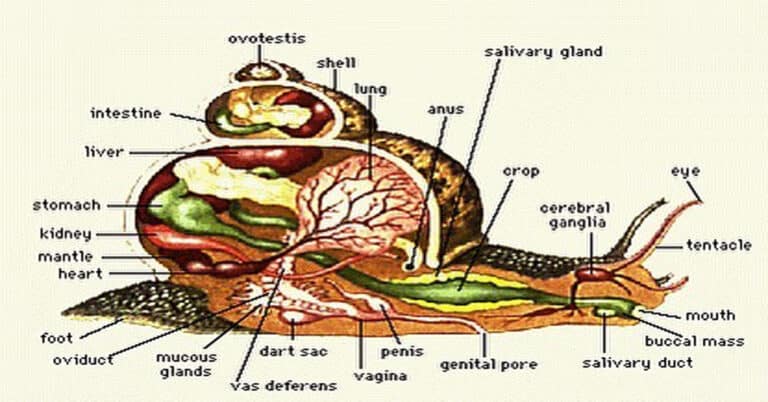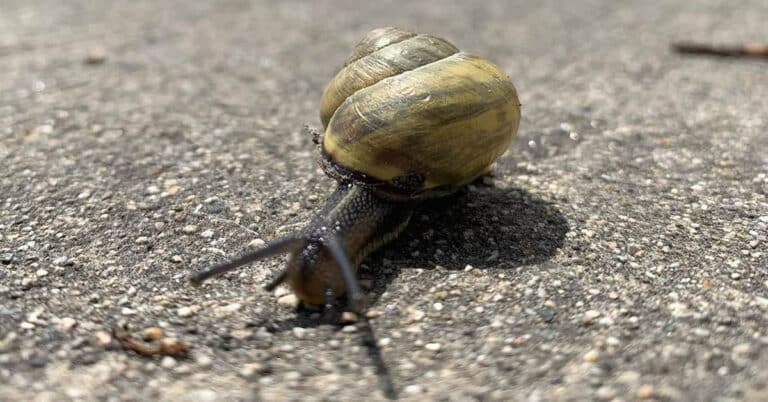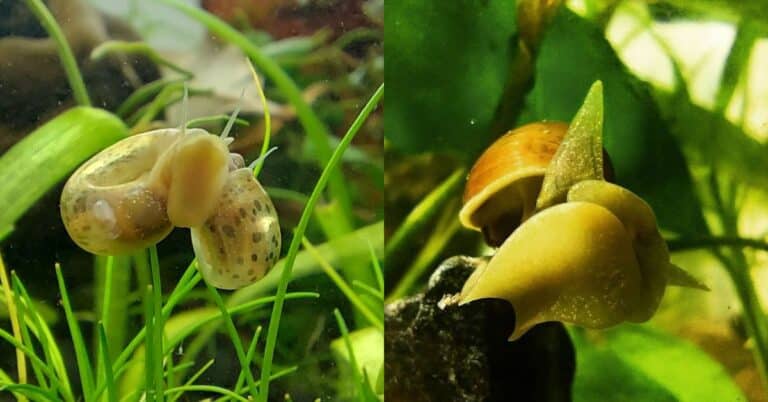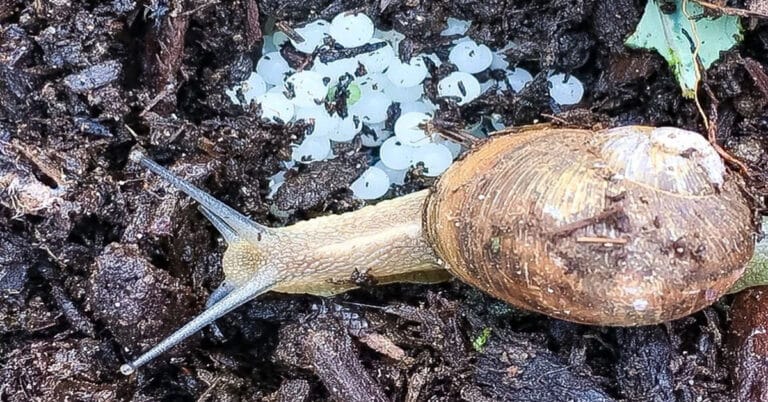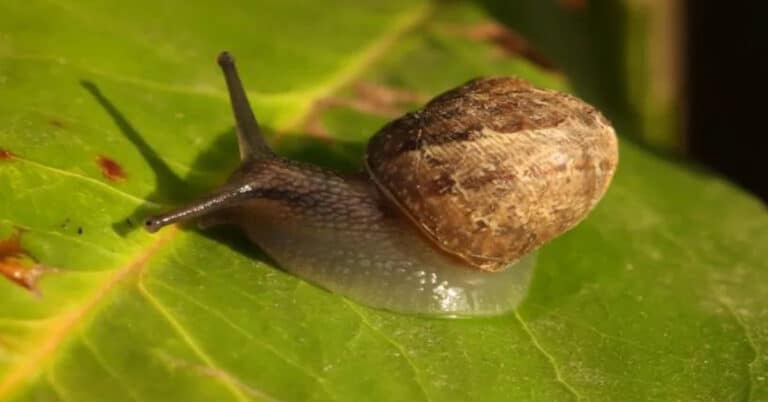Giant African Land Snail – Facts, Characteristics & Habits
Have you heard about giant African land snails? This creature is famous for being one of the largest and most harmful land snail species in the world. Since they are frequently imported illegally for the pet and shell trades and occasionally utilized in educational contexts, they make pretty interesting species.
The “Achatina fulica” is one of the most invasive species on the planet, and the US Department of Agriculture ranks it as one of the worst species for agriculture. We will go into more detail about the enormous African land snail in this article.
How to Identify Giant African Land Snail
If you’ve never seen a giant African land snail, you should be aware that they are not the same size as your typical garden snails and have very different habits. The huge African snail’s shell may be up to 7.8 inches long and 2.7–3.9 inches tall. An adult typically weighs 32 grams. Two short and two long tentacles with eyes cover their bodies.
The habitat that a gigantic African land snail lives in has a significant impact on the color of the snail. However, the majority of species have vertical golden stripes on a slightly dark brown or reddish background. The radula, a tongue-like feature in the snail’s mouth, is an essential component of its anatomy. Because of their little teeth, snails may scrape their food before consuming it.
Like other snails, they have a muscular foot that aids in movement and releases mucus to lessen friction and prevent tissue damage.
Range and Distribution
Although it originated in coastal east Africa, the huge African snail is now widespread throughout Asia, the Pacific, the Americas, and Europe. The giant African snail may be found in brush, urban areas, agricultural plantations, and coastal and natural habitats. Surprisingly, some European nations even sell and grow snails as pets. The huge African land snail is now not allowed in New York due to the state’s unlawful pet trade.
These snail species are very adaptable to a variety of environments and will change their life cycle to fit the local environment. Although they can travel up to 50 miles in a single night, they seldom travel more than 250 miles in a single year. The primary methods of human-assisted long-distance dissemination are trade and transportation. Massive African snails have been discovered fastened to machinery and cargo containers. Their eggs have been discovered in the soil around imported products.
When Are They The Most Active?
Since sunlight will kill them, enormous African land snails are most active at night. During the day, to avoid overheating or overcooling, the snail hides within its shell or burrows beneath the ground. Additionally, many snail species live solitary lives. It is an animal that is not social and, in most cases, does not interact or converse with other animals.
Although this snail has no sense of hearing, it has a keen sense of smell that helps it find partners, food sources, predators, and dangers quickly.
Life Cycle of Giant African Snails
The interesting thing about snails is that they have both sexes. A mating couple will generate kids since both partners may fertilize each other at the same time. Although hibernation can extend life by up to nine years, the average lifespan is three to five years.
A female giant African land snail may produce over 1000 eggs in her lifetime after reaching sexual maturity at 6 months. Eggs will hatch 11 days after being deposited under optimal circumstances.
The snail can continue to lay viable eggs for more than a year after a single mating. Single snails can lay more than 1,200 eggs annually.
What do Giant African Land Snails Eat?
The giant African land snail is an omnivore that consumes a diverse range of things in the wild, including grasses, plants, dead animals, leaf litter, fallen fruit, rotting vegetation, decaying wood, and leaf litter.
By nature, giant African land snails are not picky eaters. Anything that these snails come upon will be consumed. Older snails like to consume ornamental and crop plants, including bananas, beans, brassicas, cucurbits, peas, and cocoa.
A healthy diet necessary for snails includes the following:
- Vegetables
- Fruits
- Protein
- Calcium
Are Giant African Land Snails Dangerous?
Yes, they are! Giant African snails are invasive, highly adaptable creatures that represent a significant threat to agricultural goods, natural resources, and human health. Did you know that they are known to consume more than 500 different plant species when introduced into the ecosystem, many of which are well-known fruits, vegetables, and ornamental plants?
Even more, house paint and stucco have been seen being consumed by them. Giant African snails can also carry a variety of plant and animal infections, including a parasitic worm that may cause meningitis in people, so it’s not the best option to keep them as pets.
The snail’s range is constrained by cold temperatures, wetness, soil calcium needed for its shell, and other factors. The giant African snail is a threat in part because of its quick reproduction. They can survive for over a decade and reach reproductive age in as little as five to six months.
The stink that emerges from deceased snails makes the giant African snail an annoyance to people when there is a significant infestation. When calcium carbonate from shells neutralizes acidic soils, decaying snail shells can change the properties of the soil.
Can You Get Away From Them?
The giant African snail is currently officially listed as one of the top national pest risks by the Animal and Plant Health Inspection Service of the U.S. Department of Agriculture. Even chilly northern regions are at risk from the species since Florida and Hawaii are currently under quarantine, and 14 additional states are ideal candidates for invasions.
However, using good sanitation techniques in your yard and garden will help you identify and get rid of favored hiding places for giant African land snails, such as wet leaves, garden trash, logs, or upside-down flower pots. Long mucus and slime trails, extensive plant chewing damage, and large, ribbon-like excrement are all signs that these snails may be at work.
They often stay quite near the nest and eat at night and in the morning when the soil is damp, although they will also feed on cloudy days. They may burrow into the ground during dry spells, where they can remain safe and dormant for up to a year.
How To Handle Giant African Land Snails
Handling a giant African land snail is difficult, but not impossible. So you will need these suggestions in case you want to prevent them from entering your garden.
- Never handle them with salty hands.
- Despite having a robust shell, the giant African land snail should still be handled cautiously, and you should avoid plucking at the base of the shell to avoid shell damage. Remove the suction holding the snail to the surface by gently moving beneath it, and then pick it up.
- Use moistened hands or gloves to handle the large African land snails first. To be safe, it is advised that you put on a glove before handling or contacting this snail. This is done to prevent you from contracting snail sickness.
- Always wash your hands with soap and water right away after contacting or handling this snail, in general.
Housing Giant African Land Snails
The ideal approach to taking care of your giant African land snail as a pet is to keep it in a covered glass or plastic tank that you can fill with dirt or compost to allow your snail to readily burrow. Because each species of the giant African land snail has different requirements for humidity and temperature, housing them together is not a good idea.
For their survival, giant African land snails require a lot of room. At least a 5-gallon glass or plastic tank with a screen top to prevent escape would be a good choice for the beginning. However, as they develop, additional space could be needed. Avoid placing the tank in areas with severe temperatures, near windows, or in direct sunlight.
The vast African continent Snail care is simple once you establish a regimen. An exceptional and simple-to-care-for pet, Achatina Fulica thrives in the right tank environment. As a snail owner, you should regularly examine the well-being of your snails and look out for any indications of concern. The majority of issues are brought on by bad feeding habits, low humidity, and poor tank maintenance.
Final Words
Giant African land snails are considered dangerous and even banned in some countries. However, if you decide to keep them as a pet at home, make sure you have all the necessary information about the laws and regulations in your country and have enough experience and relevant conditions for keeping them.
One disadvantage of keeping giant African land snails as pets is that they can carry parasites that are harmful to humans. The parasite is present in rats and is spread by their feces, which snails can subsequently consume. However, as long as they are kept in hygienic circumstances and are captive-bred, they typically do not have these types of infections and are safe to handle.

Nato is a content writer and researcher with a background in psychology who’s eager to explore the wonders of nature. As a travel enthusiast and animal lover, she hopes to inspire others to discover and cherish the beauty and importance of the natural world.

